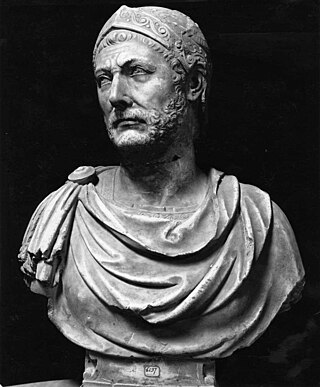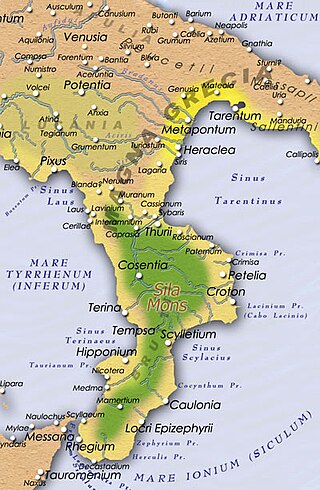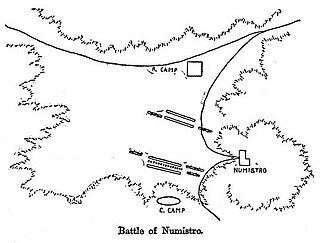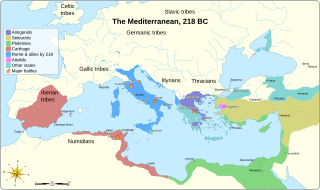Developments in southern Italy until 210 BC
Following his incursion into southern Italy in 217 BC, Hannibal defeated the Roman forces in the battle of Cannae (216 BC). This victory brought him a host of new allies from Campania, Samnium, Apulia, Lucania, Bruttium, and Magna Graecia, who revolted from Rome enticed by his narrative of Roman oppression. One of these allies was the city of Herdonia in northern Apulia. It was the site of a general engagement between Hannibal and the Romans already in 212 BC (see the first battle of Herdonia), because despite the severe defeats on the battlefield, Rome still managed to preserve intact the core of its system of alliances in Italy and continued to mount a slow but steady counter-offensive. [2]
The first battle of Herdonia ended with the almost total annihilation of the troops led by the praetor Gnaeus Fulvius Flaccus. [3] However Flaccus' army was just a fraction of the forces fielded by Rome. The siege of Capua, which had begun years before, ended in 211 BC with the fall of the largest city that had taken the side of Hannibal after Cannae. The Carthaginian's inability to defend Capua reversed the mood among many of his allies and Hannibal's position began to weaken. [4]
Marcellus' successes and Centumalus' demise
The Roman advance in southern Italy continued in 210 BC. Two armies stood against Hannibal in Apulia. One was under the consul Marcus Claudius Marcellus. The proconsul Gnaeus Fulvius Centumalus commanded the other. Their overall strength was four Roman legions, plus an approximately equal allied contingent. [5] Since they operated not far from each other, Hannibal did not dare to challenge them. This allowed Marcellus to capture the city of Salapia (see the map), that was betrayed to him by a fraction of its citizens, and to destroy the Carthaginian garrison. [6]
Following this setback, Hannibal retreated and a rumour was spread that he was going away to Bruttium. Upon learning this, Marcellus moved to Samnium and reduced two more towns that served as Carthaginian bases in this region. [7] Meanwhile, Hannibal returned to northern Apulia with forced marches and managed to catch Centumalus off-guard when the latter was besieging Herdonia. Despite the Carthaginian numerical superiority the proconsul did not decline the battle. He arranged his army in two battle lines and clashed with the Carthaginian infantry. Hannibal waited until the Romans and their allies were fully engaged and sent his Numidian cavalry to surround them. Part of the Numidians attacked the Roman camp which was insufficiently protected. The others fell upon the rear legion and dispersed it. The same happened to the Romans fighting in the front line. Centumalus, eleven (out of twelve) military tribunes, and 7,000–13,000 [8] soldiers were slain. The rest were scattered and some escaped to Marcellus in Samnium. [5] [7]
Repercussions on Rome
The victory did not bring strategic advantages to Hannibal. Judging that in the long run he could not retain Herdonia, the Carthaginian general decided to resettle its population in Metapontum and Thurii to the south and destroy the city itself. [9] Before that he set an example to other eventual traitors by executing some of the distinguished citizens who had conspired to betray Herdonia to Centumalus. [7] For the rest of the summer he was forced to fight off the second Roman army. The next battle with Marcellus at Numistro was inconclusive [10] and Hannibal was unable to regain the positions lost at the beginning of the campaign.
The second defeat at Herdonia did not make the Roman Senate change its warlike stance. Once again, as in the aftermath of Cannae, the senators resorted to punitive actions against the remnants of the defeated army. 4,344 men were rounded up and sent to Sicily where they joined the survivors of Cannae and were sentenced to serve on the island until the end of the war. [11] This had undesired repercussions. The deportation of the soldiers, most of whom were of Latin origin, caused considerable discontent among the Latin colonies which had already been drained by ten years of continuous warfare on Italian soil. Amidst great want of additional manpower and financial resources twelve out of thirty colonies refused to send any more levies and money to Rome. This crisis continued for five years and put severe strain on the Roman war effort. [4] [12]

Hannibal was a Carthaginian general and statesman who commanded the forces of Carthage in their battle against the Roman Republic during the Second Punic War.
This article concerns the period 219 BC – 210 BC.
Year 210 BC was a year of the pre-Julian Roman calendar. At the time it was known as the Year of the Consulship of Marcellus and Laevinus. The denomination 210 BC for this year has been used since the early medieval period, when the Anno Domini calendar era became the prevalent method in Europe for naming years.
Year 212 BC was a year of the pre-Julian Roman calendar. At the time it was known as the Year of the Consulship of Flaccus and Pulcher. The denomination 212 BC for this year has been used since the early medieval period, when the Anno Domini calendar era became the prevalent method in Europe for naming years.

Year 216 BC was a year of the pre-Julian Roman calendar. At the time it was known as the Year of the Consulship of Varro and Paullus. The denomination 216 BC for this year has been used since the early medieval period, when the Anno Domini calendar era became the prevalent method in Europe for naming years.

Marcus Claudius Marcellus, five times elected as consul of the Roman Republic, was an important Roman military leader during the Gallic War of 225 BC and the Second Punic War. Marcellus gained the most prestigious award a Roman general could earn, the spolia opima, for killing the Gallic military leader and king Viridomarus in single combat in 222 BC at the Battle of Clastidium. Furthermore, he is noted for having conquered the fortified city of Syracuse in a protracted siege during which Archimedes, the famous mathematician, scientist, and inventor, was killed, despite Marcellus ordering the soldiers under his command not to harm him. Marcus Claudius Marcellus died in battle in 208 BC, leaving behind a legacy of military conquests and a reinvigorated Roman legend of the spolia opima.
The gens Fulvia, originally Foulvia, was one of the most illustrious plebeian families at ancient Rome. Members of this gens first came to prominence during the middle Republic; the first to attain the consulship was Lucius Fulvius Curvus in 322 BC. From that time, the Fulvii were active in the politics of the Roman state, and gained a reputation for excellent military leaders.
Appius Claudius Pulcher was a Roman general and politician of the 3rd century BC, active in the Second Punic War.

The Battles of Kroton in 204 and 203 BC were, as well as the raid in Cisalpine Gaul, the last larger scale engagements between the Romans and the Carthaginians in Italy during the Second Punic War. After Hannibal’s retreat to Bruttium due to the Metaurus debacle, the Romans continuously tried to block his forces from gaining access to the Ionian Sea and cut his eventual escape to Carthage by capturing Kroton, the last port which had remained in his hands after years of fighting.

The first Battle of Herdonia was fought in 212 BC during the Second Punic War between Hannibal's Carthaginian army and Roman forces led by Praetor Gnaeus Fulvius Flaccus, brother of the consul. The Roman army was destroyed, leaving Apulia free of Romans for the year.

The First Battle of Capua was fought in 212 BC between Hannibal and two Roman consular armies. The Roman force was led by two consuls, Quintus Fulvius Flaccus and Appius Claudius Pulcher. The Roman force was defeated, but managed to escape. Hannibal temporarily managed to raise the siege of Capua. A tactical Carthaginian victory, it ultimately did not help the Capuans.

The Battle of the Silarus was fought in 212 BC between Hannibal's army and a Roman force led by centurion Marcus Centenius Penula. The Carthaginians were victorious, destroying the entire Roman army and killing 15,000 Roman soldiers in the process.

The Battle of Numistro was fought in 210 BC between Hannibal's army and one of the Roman consular armies led by consul Marcus Claudius Marcellus. It was the fourth time they met in a battle. Previous encounters were located around the walls of Nola (Campania) in 216, 215, and 214 and had been favourable for the Roman side.
Marcus Valerius Laevinus was a Roman consul and commander who rose to prominence during the Second Punic War and corresponding First Macedonian War. A member of the gens Valeria, an old patrician family believed to have migrated to Rome under the Sabine king T. Tatius, Laevinus played an integral role in the containment of the Macedonian threat.
Hanno, distinguished as the son of the suffet Bomilcar, was a Carthaginian officer in the Second Punic War.

The Battle of Insubria in 203 BC was the culmination of a major war, carried out by the Carthaginian commander Mago, brother of Hannibal Barca, at the end of the Second Punic war between Rome and Carthage in what is now northwestern Italy. Mago had landed at Genoa, Liguria, two years before, in an effort to keep the Romans busy to the North and thus hamper indirectly their plans to invade Carthage's hinterland in Africa. He was quite successful in reigniting the unrest among various peoples against the Roman dominance. Rome was forced to concentrate large forces against him which finally resulted in a battle fought in the land of the Insubres (Lombardy). Mago suffered defeat and had to retreat. The strategy to divert the enemy's forces failed as the Roman general Publius Cornelius Scipio laid waste to Africa and wiped out the Carthaginian armies that were sent to destroy the invader. To counter Scipio, the Carthaginian government recalled Mago from Italy. However, the remnants of the Carthaginian forces in Cisalpine Gaul continued to harass the Romans for several years after the end of the war.

Quintus Caecilius Metellus was a pontiff in 216 BC, aedile of the plebeians in 209 BC, curule aedile in 208 BC, magister equitum in 207 BC, consul in 206 BC, dictator in 205 BC, proconsul of Bruttium in 204 BC, and an ambassador at the court of Philip V of Macedon in 185 BC.

The Battle of Canusium also known as the Battle of Asculum was a three-day engagement between the forces of Rome and Carthage. It took place in Apulia during the spring of 209 BC, the tenth year of the Second Punic War. A larger Roman offensive, of which it was a part, aimed to subjugate and to punish cities and tribes that had abandoned the alliance with Rome after the Battle of Cannae, and to narrow the base of the Carthaginian leader, Hannibal, in southern Italy.
Gnaeus Fulvius Centumalus Maximus was a consul of the Roman Republic in 211 BC. As consul, Fulvius defended Rome against Hannibal with his colleague Publius Sulpicius Galba Maximus during the Second Punic War.











